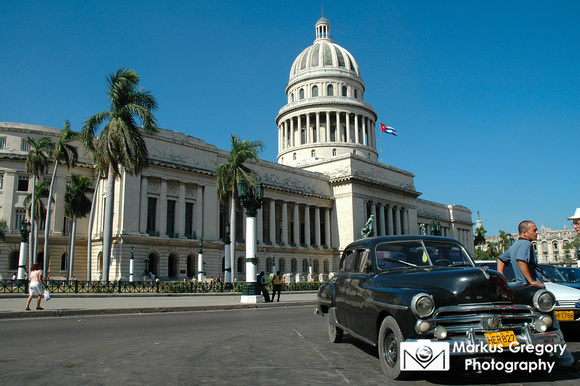El Capitolio, or
National Capitol Building in
Havana,
Cuba, was the seat of government in Cuba until after the
Cuban Revolution in 1959, and is now home to the
Cuban Academy of Sciences. Its design and name recall the
United States Capitol in
Washington, D.C., but it is only superficially similar. Completed in 1929, it was the tallest building in Havana until the 1950s and houses the world's third largest indoor statue.
The site occupied by El Capitolio was originally an area of swamp which was later used for slave dwellings and later still for the country's first botanical garden. In 1839, after the plants were relocated, the Villanueva Station (
Estación de Ferrocarriles de Villanueva) was constructed on the site. The station was inaugurated in 1839 and was in use until the first decade of the 20th century when a modern station was constructed further to the east of the city. Before the existing building was erected there were other construction projects proposed for the site. The first, proposed in 1912, was to build a Presidential Palace, but the idea was later modified to construction of a building for the Cuban legislature. Financing was obtained and the work started in December 1917 but stopped during
World War I and was never recommenced. The dome of the building, which had been completed before work was suspended, was destroyed in an explosion in 1918.
View from a nearby building
In 1925, the dictator
Gerardo Machado took power and commissioned a new design from the architects Raúl Otero and Eugenio Raynieri. The previous, partially completed building was demolished and work began on the new building on 1 April 1926. Over seen by the U.S. firm of Purdy and Henderson, 8,000 labourers worked 8-hour shifts 24 hours a day, and as a result the building was completed in just 3 years and 50 days.
The building was named after a referendum on the choice of either the
El Palacio del Congreso (
Palace of Congress) or
El Capitolio, and was inaugurated on 20 May 1929. The legislature did not move into the building until February 1931, as although the structure was complete by 1929 it took almost another two years before the interior decoration was finished. The building is finished with fine marble throughout and the total cost of construction and decoration is estimated to have been 17 million
pesos. The building served as the seat of the legislature until the late 1950s; both the House of Representatives and Senate were based in the building. In the 1960s it became home to the Ministry of Science, Technology and the Environment. The main floor (which is on the first storey) is open to visitors and many of the rooms are used to host conferences and meetings.
From Wikipedia, the free encyclopedia


